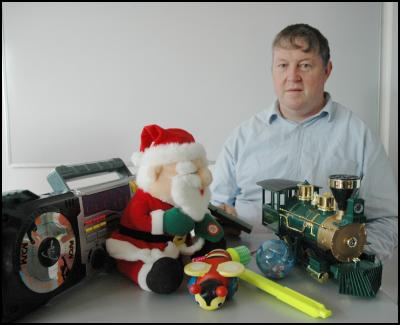Noisy toys damage children’s hearing
Noisy toys damage children’s
hearing

Click for big version
An environmental health
specialist says noisy toys that could damage children’s
hearing are still being imported into New Zealand and sold
in shops despite a warning seven years ago of the danger.
Stuart McLaren, a senior lecturer in the Institute of Food, Nutrition and Human Health at the Wellington campus, says many toys on the market are potentially damaging to sensitive little ears.
“Parents and childcare workers should stop to think about the noise that toys make, and how this noise could be causing injuries to babies and toddlers – those who don't or can't automatically pull away from a painful sound,” says Mr McLaren.
“New toys come on the market every year. To test the container loads that pour into New Zealand in the lead up to Christmas is impossible without a huge increase in resources.”
Mr McLaren says another issue is that many toys default to the loudest volume every time they are turned on.
“You have to manually reduce the volume every time the toy is turned on. When it is turned off you are back to square one.”
Mr McLaren says the worst toy he ever tested was an air horn toy for toddlers that produced more than 112dB at a distance of half a metre.
While these have not been seen in shops recently, he says a request to the Ministry of Consumer Affairs will be lodged if they or any toys like them return to the shelves.
A 30-second exposure to such noise amounts to the legal limit at an industrial site over an eight-hour day.
Toys in Mr McLaren’s “bag of shame” include toy ghetto blasters, toy musical instruments, cap pistols, whistles, clackers, clickers, toy cell phones and some train sets.
He says the squeaks, bangs, ringing, whistles and clicks these toys produce could all be dangerous. Loud music and sirens could also cause problems. Toys producing sharp, impact sounds are potentially the most hazardous.
"Parents and child care-givers are buying such toys in good faith, with the belief that they are safe. I suspect many are unaware that these toys could be damaging to young ears.
“If parents think a toy is too loud, then it probably is.”
Exposure to excessive or unwanted noise affects our health and well being. The result may be significant hearing loss, with the accompanying trauma of social isolation later in life.
An estimated 6–10 per cent of children are suffering hearing damage by the time they reach school.
Mr McLaren says there is no legislation specifically covering noisy toys, nor is there mandatory testing of toys prior to going on sale.
ENDS


 University of Auckland: Tributes Flow For Much Loved Pacific Leader Melegalenu’u Ah Sam
University of Auckland: Tributes Flow For Much Loved Pacific Leader Melegalenu’u Ah Sam NZEI: Ministry Of Education Cuts Will Disproportionately Affect Pasifika
NZEI: Ministry Of Education Cuts Will Disproportionately Affect Pasifika Day One Hapai te Haeata: Call To Action For Young Filmmakers Against The Backdrop Of Funding Cuts
Day One Hapai te Haeata: Call To Action For Young Filmmakers Against The Backdrop Of Funding Cuts Toyota New Zealand: Three Races For Top Three To Decide TR86 Title
Toyota New Zealand: Three Races For Top Three To Decide TR86 Title Wellington City Council: Wellington Is All Action Stations For The Faultline Ultra Festival
Wellington City Council: Wellington Is All Action Stations For The Faultline Ultra Festival Melanie Allison: Local Playwright Casts A Spell Over Hamilton
Melanie Allison: Local Playwright Casts A Spell Over Hamilton